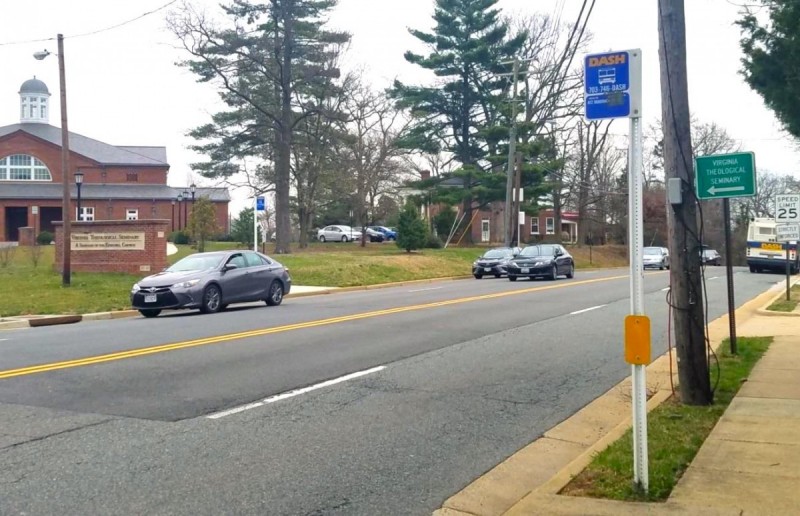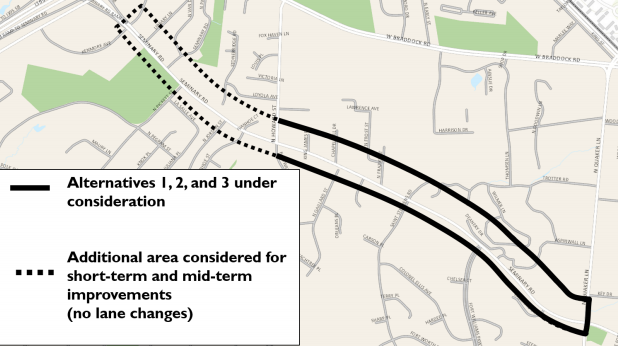Alexandria wants to make Seminary Road safer for all travelers. Some residents aren’t happy.

Fort Williams Parkway Bus Stop on Seminary Road in Alexandria, Virginia. Image by the author.
Seminary Road, an important artery in the City of Alexandria, is often congested and is especially dangerous for people bicycling and walking. The city has a plan to fix a 0.9-mile section east of I-395, but some residents are vehemently opposed to it.
“Crossing multiple lanes of traffic is scary, unpredictable, and can lead to some of the deadliest crash scenarios for pedestrians possible,” Alexandria’s former Pedestrian and Bicycle Program Manager Darren Buck testified at a recent public hearing.
On Thursday, May 30, Alexandria Transportation Planning staff will present their recommendations for how to make this section a “Complete Street,” a design that improves safety for people traveling via all modes. The redesign could include two travel lanes, a center turn lane, and bicycle lanes. Some drivers are worried this will significantly slow their trips, but decades of research indicate otherwise.
Area of Seminary Road included in this project. Image by the City of Alexandria. 
Seminary Road could get a “road diet” and bike lanes
At a March 25 community meeting, city staff presented three potential alternatives for the section of Seminary Road east of N. Howard Street. Alternative 3 would provide all road users with safe accommodations, including a center left-turn lanes for drivers, refuge islands for people who walk or take the bus, and lanes for people who bike. This design is most consistent with the city’s Complete Streets Policy and its Vision Zero goal to eliminate traffic fatalities and serious injuries by 2028.
In order to install these safety measures, one lane needs to be reallocated into a center turn lane and the other into space for people bicycling and walking. This is called a “road diet.” It’s a Federal Highway Administration (FHWA) “Proven Countermeasure,” which means it’s been proven to be effective and beneficial.
Currently, left-turning vehicles risk both rear-end and left turn crashes and disrupt traffic flow. Center left-turn lanes help drivers because they reduce crashes by 37% and enable traffic to flow more smoothly. That’s because drivers don’t have to change lanes to avoid turning vehicles.
A crash on Seminary Road, one of 22 in the past three years. Image by the author.
While people frequently bike in the Seminary Road corridor, only a few fearless ones use the roadway. But that could change if the right infrastructure is installed. Buffered bike lanes encourage more people to bike, the National Association of City Transportation Officials (NACTO) notes. Alexandria’s own 2016 Transportation Master Plan recommends the Seminary Road corridor as a top 10 priority for protected or buffered bike lanes.
Bike to School Day on Seminary Road. Image by the author.
Alexandria’s Environmental Action Plan (EAP) recommends this type of design as well, and calls for the city to “move aggressively toward a culture of city streets that puts ‘people first’ by implementing development and transportation projects consistent with the following level of precedence: pedestrians, bicyclists, public transportation, shared motor vehicles, and private motor vehicles.” The city’s Transportation Master Plan also calls for bike lanes on this section of Seminary Road.
Some drivers are fighting the Complete Streets plan
However, some neighborhood associations are fiercely opposing the plan. Residents are frustrated by increasing amounts of traffic, and some think reducing car lanes to make way for safety improvements will slow drivers down too much. Some also think the plan caters to a minority of residents at the expense of a majority who drive.
Reconfiguring Seminary Road “would be a prescription for gridlock,” writes resident Bill Goff in an opinion letter in The Connection. “We do not need Vision Zero — we do need four lanes on Seminary Road.”
“Every civic association in the area affected has opposed the change, as has the Alexandria Republican Party,” resident Jack Sullivan wrote in another recent letter to the editor.
However, experts say those fears are unfounded. City traffic analysis has forecast no more than about a 10-second delay during the very worst 15-minute period of rush hour traffic in this area.
Environmental and multi-modal transportation advocates point out that providing safe access to bus stops and bike lanes will help improve safety for everyone and promote walking, biking and transit without causing additional congestion. And Seminary Road residents observed that traffic already fits into one lane in each direction since all of the “entrances” to Seminary Road east of N. Howard Street are only a lane wide.
“The road diet plan would merely serve to limit the ability of speeding cars to weave between traffic traveling close to the speed limit,” local resident John Yuda pointed out in an opinion letter in the Alexandria Times.
Seminary Road at N. Howard Street with arrows that indicate east-bound through-traffic is already confined to one lane. Image created with Google Maps. 
Fortunately, there’s a local example we can look at. In 2016, Alexandria installed a similar Complete Streets project on King Street. So how did it go?
By all measures, it was a success. Average vehicle speeds went down by 18%, the average annual number of crashes were halved, and no traffic was diverted onto side streets, as some residents feared. Data collected before and after the project showed that the volume of traffic was unchanged.
Center left-turn lanes installed with 2016 King Street Complete Streets project. Image by the author. Pedestrian Refuge Island installed with 2016 King Street Complete Streets project. Image by the author.

These positive results aren’t surprising. The US has been using road diets to improve safety and traffic flow for 40 years. Pedestrian refuge islands are a Federal Highway Administration “Proven Countermeasure” that reduce the likelihood of a crash with a person walking by 56%.
“I feel very strongly that Seminary Road, along with other city streets, should be revamped to include safety features such as bike lanes and better pedestrian crossings. The West End of Alexandria should not be known as the ‘car required’ part of the city.” Jesse Strauss, a resident and mother of three school-age children wrote in her own letter to the editor. “To go forward to the next phase without making these critical changes would risk setting a dangerous precedent of street engineering by popularity contest, rather than applying city policies and best practices.”
Will Alexandria try to replicate this success on Seminary Road?
What changes will staff recommend for this section of Seminary Road east of N. Howard Street? We should know by noon on Thursday, May 30 when City of Alexandria Transportation Planning staff plan to post meeting materials on the project website for review prior to their community meeting later that evening.
About 67% of Alexandria residents commute by car, truck or van as of 2017. Even though this plan would help people of all modes, the city’s survey may show that a majority of respondents favor keeping four lanes. It’s important to make your voice heard. Resident comments will be collected at the meeting and via an online survey that will be posted afterwards. The comment period will close at 5 pm on Monday, June 10.
Staff will present their recommendations at a Seminary Road Complete Streets Project community meeting on Thursday, May 30, from 7 to 9 pm at the St. Stephens & St. Agnes Upper School, 1000 St. Stephens Road in Alexandria, VA. If you’re unable to attend in person, it will be live streamed on the Department of Transportation & Environmental Services Facebook page.
